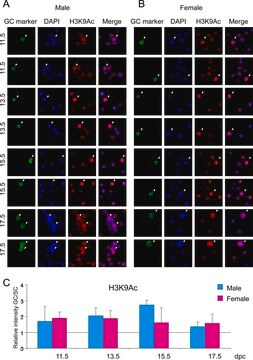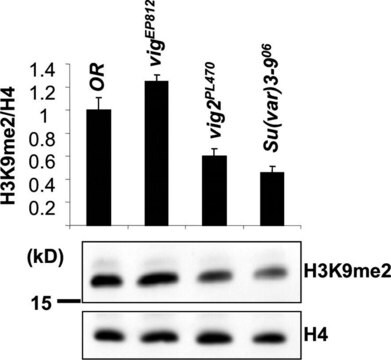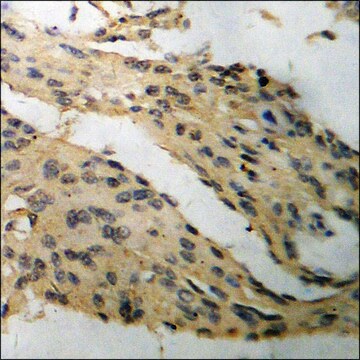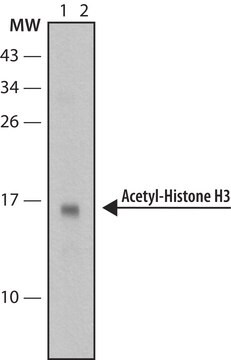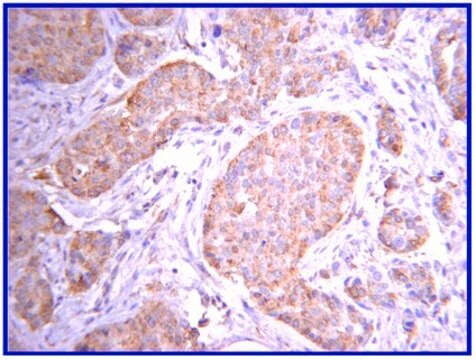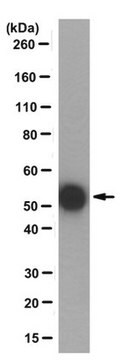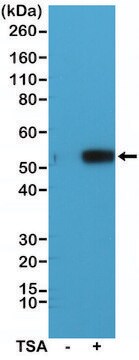04-119
Anti-acetyl-Histone H4 (Lys12) Antibody, rabbit monoclonal
culture supernatant, from rabbit
Synonim(y):
H4K12Ac, Histone H4 (acetyl K12)
About This Item
Polecane produkty
pochodzenie biologiczne
rabbit
Poziom jakości
forma przeciwciała
culture supernatant
rodzaj przeciwciała
primary antibodies
klon
monoclonal
reaktywność gatunkowa
human, vertebrates
producent / nazwa handlowa
Chemicon®
Upstate®
metody
ChIP: suitable
dot blot: suitable
western blot: suitable
izotyp
IgG
numer dostępu NCBI
numer dostępu UniProt
Warunki transportu
wet ice
docelowa modyfikacja potranslacyjna
acetylation (Lys12)
informacje o genach
human ... H4C1(8359)
Specyficzność
Immunogen
Zastosowanie
Sonicated chromatin prepared from HeLa cells (1 X 10E6 cell equivalents per IP) were subjected to chromatin immunoprecipitation using either 2 µL of Negative Control Supernatant, or 2 µL of Anti-Acetyl-Histone H4 (Lys12) and the Magna ChIP A Kit (Cat. # 17-610).
Successful immunoprecipitation of Acetyl-Histone H4 (Lys12)-associated DNA fragments was verified by qPCR using ChIP Primers, human GAPDH Coding Region as a positive locus, and a gene desert region as a negative locus. (Figure 2). Data is presented as percent input of each IP sample relative to input chromatin for each amplicon and ChIP sample as indicated.
Please refer to the EZ-Magna ChIP A (Cat. # 17-408) or EZ-ChIP (Cat. # 17-371) protocol for experimental details.
Western Blot Analysis:
Lysates from HeLa cells untreated or sodium butyrate treated (Lanes 1 and 2 respectively) were resolved probed with anti-acetyl-Histone H4 (Lys12) (1:1,000). Arrow indicates Acetyl-Histone H4 (Lys12).
Arrow indicates Acetyl-Histone H4 (Lys12) (~11 kDa)
Epigenetics & Nuclear Function
Histones
Chromatin Biology
Jakość
Opis wartości docelowych
Postać fizyczna
Przechowywanie i stabilność
Informacje prawne
Oświadczenie o zrzeczeniu się odpowiedzialności
Nie możesz znaleźć właściwego produktu?
Wypróbuj nasz Narzędzie selektora produktów.
Kod klasy składowania
12 - Non Combustible Liquids
Klasa zagrożenia wodnego (WGK)
WGK 1
Temperatura zapłonu (°F)
Not applicable
Temperatura zapłonu (°C)
Not applicable
Certyfikaty analizy (CoA)
Poszukaj Certyfikaty analizy (CoA), wpisując numer partii/serii produktów. Numery serii i partii można znaleźć na etykiecie produktu po słowach „seria” lub „partia”.
Masz już ten produkt?
Dokumenty związane z niedawno zakupionymi produktami zostały zamieszczone w Bibliotece dokumentów.
Nasz zespół naukowców ma doświadczenie we wszystkich obszarach badań, w tym w naukach przyrodniczych, materiałoznawstwie, syntezie chemicznej, chromatografii, analityce i wielu innych dziedzinach.
Skontaktuj się z zespołem ds. pomocy technicznej
